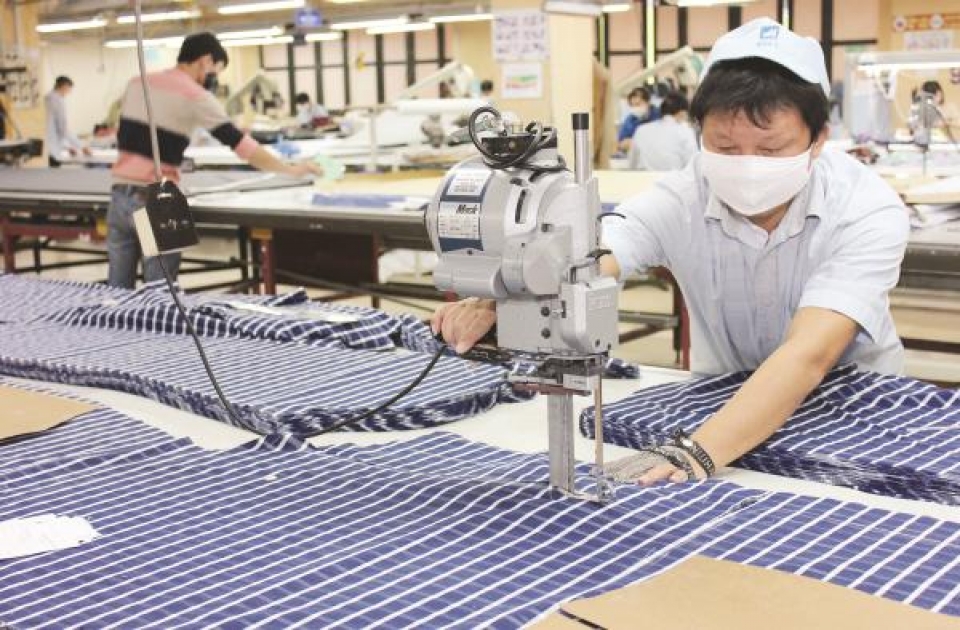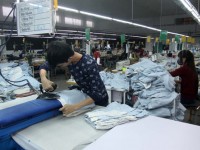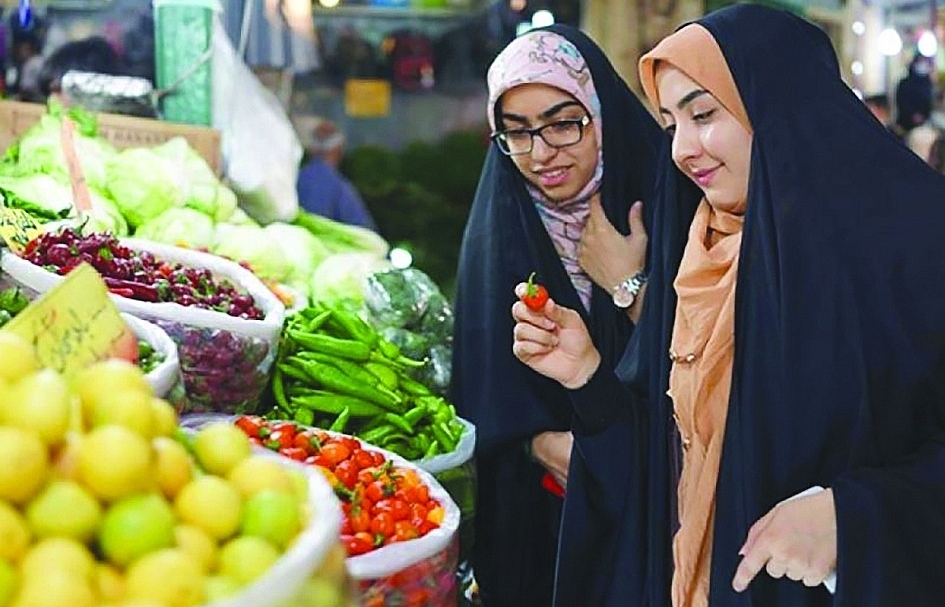Textile and Garment Industry still in a difficult position
| Textiles and Garments: profits do not increase with revenues | |
| In innovation, Vietnam said to be losing competitive edge | |
| Why Vietnamese textiles industry export figures are different from Customs? |
 |
| Materials still depend on import in the Garment and Textile industry’s bottlenecks. Photo: Phan Thu |
Cutthroat competition
| With forecastingstill difficult, the Textile and Garment industry does not set the goal of 10-12% growth like every year, just projected to increase 6.5-7% is in 2017, equivalent to about $US 30 billion. |
Mr. Vu DucGiang, Chairman of Vietnam Textile and Apparel Association (VITAS) said, the main reason which causes the Textile and Garment industry’s low growth is due to the difficulties of the world market, importing demand in the Textile and Garment major markets declined. In particular, the US fell 4.74%, the EU fell 1.5%, South Korea slipped 0.2%, only the Japanese market increased slightly to 3.6%. Especially, 2016 witnessed the fierce competition of Textile and Garment products from China, India, Pakistan, and Bangladesh. These countries enjoy many preferential policies from their government, especially in the exchange rate against the dollar to develop Textile and Garment sector and attract orders.
While other countries enjoy preferential policies, the domestic Textile and Garment industry has not yet received the necessary support from Tax policiesowing to the Free Trade Agreements (FTA) such as Vietnam - EUFTA (EVFTA),and Agreement on the Trans-Pacific Partnership (TPP) is not yet in force in 2017. This makes prices and costs of domestic enterprises higher than other countries, and in fact orders from Vietnam have "run" to other countries such as India, Cambodia, and Myanmar. If not "saved" soon, Vietnam's Garment and Textile enterprises will continue to meet difficulties in 2017 and in the medium term.
Not only fierce competition but the Garment and Textile industry is also having difficulties such as processing and raw materials still depend on imports. According to Mr. Nguyen Son, Deputy Chairman of the Vietnam Cotton Fiber Association, the Garment and Textile industry has huge demand for cloth, but the "bottleneck" at the dyeing and textile stage of the supply chain makes the efficient operation of enterprises not high due to heavy reliance on imported fabric mainly from China. Therefore, the dependence onimportant raw materials, especially the supply of fabrics, cotton, and yarn continues to bottleneck, and pulls the performance of the Garment and Textile industry back. Especially with a series of FTAs in force, with the rules of origin of fabric, and yarn will make enterprises get have difficulty in getting the certificate of origin for the tax rate of 0%. However, sources of raw materials will continue to be in shortage as TPP has not been decided leading to FDIin textiles and dyeing being paused.
Being dependent on imported materials is also one of the reasons for Garment and Textile enterprises to not yet be deeply involved in the Garment and Textile supply chain and mainly involved in the processing stage – the lowest added value stage in the supply chain of Garment and Textiles. According to VITAS, Vietnam's position in the world Garment and Textile supply chain is just processing, garment export brings less added value like Bangladesh, Srilanka. While the developed countries such as the US, the EU, Japan focuse on stages which bring the highest surplus value (design, marketing and distribution), and outsourcing contractors and wholesalers gather in 3 countries/regions - South Korea, Hong Kong, and Taiwan then connect manufacturingcompanies to final consumers.
Starting in business
According to the MOIT’s forecast, 2017 and the coming years, besidessome opportunities, international economic integration also brings many challenges, especially for small and medium-sized enterprisesGarment and Textile companies with a low base, competition in the context of integration is very difficult. Even enterprises may lose theirs traditional contracts to higher competitiveness ones, especially FDI enterprises.
In order to make Vietnam's Garment and Textile sector to develop steadily, and enhance competitiveness in the future, Mr. Le Tien Truong, General Director of Vietnam Textile and Garment Group recommended, the State should create a fair business environment between FDI and domestic enterprises; and better management of investment projects in Garment and Textiles. Besides, the Government should also adjust the Garment and Textileindustry development plan appropriately with the speed of Vietnam integration.
Emphasizing competition among domestic enterprises and FDI enterprises, some economists said, the stitching garment stage is suitable and creates more jobs with the capabilities of domestic companies, therefore no need to attract FDI in Garment and Textiles. Just attract FDI in knitting,and dyeing stages but choose the investment positions, strict environmental requirements, select projects with modern technologies, prioritize investors associated with Vietnam enterprises to invest in knitting and dyeing. In addition, the Government also need to support about finance, banks should have preferential credit for domestic companies that invest in textile and dyeing to create materials originating from Vietnam and get the tariff benefit.
 | VN garment sector faces rough 2017 |
On the other hand, in the Garment and Textile sector, the biggest beneficiariesare the first and the last stages, which are designing and marketing stages. If domestic enterprises do not get bigger to participate in the whole chain and just participate in the lowest stages then the benefits are not there. The State should also research to help enterprises to engage in the supply chain and not just interest in supporting industrial development, this is the solution for the sustainable development of the industry.
Of course, enterprises still have in mind to "save" themselves before being “saved” by continuing to focus on exploiting more efficiency from invested equipment, i.e. reducing investment in the width, opening more factories in places by creating new jobs, but based on fixed assets that they have already. Enterprises are also thinking of using fixed assets with the highest possible performance in the coming years, with finance costs decreased but still create jobs, increase productivity. Notably, improving productivity is the key factor. This does not just come from shortening process, and optimizing, but also includes the replacement of the less effective machines usingmore labor by a high level of automation, the goal is to reduce the labor costs productcosts . "Continue looking for branched markets, which have small and medium-sized orders, but difficult, to keep identifying advantages," Mr. Truong stressed.
Related News

Risks for the economy when cash flow has not yet been put in to production and business
10:49 | 07/10/2024 Headlines

Mobilizing finance for the low-emission rice value chain
10:42 | 28/09/2024 Import-Export

Anti-corruption in Finance: Resolutely eliminating cumbersome administrative procedures
08:40 | 21/09/2024 Finance

Vietnam made good progress in reforming public financial management
10:37 | 26/06/2024 Finance
Latest News

Monthly aquatic exports top 1 billion USD again after 2 years
15:00 | 05/11/2024 Import-Export

EU partners no longer 'lenient', Vietnam must adapt through ESG policies
09:02 | 05/11/2024 Import-Export

Changes in Canada's trade defense laws
09:00 | 05/11/2024 Import-Export

Import and export are expected to reach 800 billion USD
13:32 | 04/11/2024 Import-Export
More News

Fresh coconuts quenching new overseas markets
13:29 | 04/11/2024 Import-Export

Rice exports likely to set new record in 2024
13:25 | 04/11/2024 Import-Export

Vietnamese goods conquer halal market through trust and quality
09:57 | 04/11/2024 Import-Export

Exporters urged to have strategies to take advantage of UKVFTA for expansion
17:33 | 03/11/2024 Import-Export

Fresh coconuts quenching new overseas markets
17:29 | 03/11/2024 Import-Export

Vietnam and UAE trade sees billion-dollar growth
07:15 | 03/11/2024 Import-Export

Sharing responsibility for ensuring security and safety of the supply chain
07:13 | 03/11/2024 Import-Export

Many factors affecting tuna exports in the last months of the year
19:38 | 02/11/2024 Import-Export

Vietnam still dominates Philippine rice import
19:36 | 02/11/2024 Import-Export
Your care

Monthly aquatic exports top 1 billion USD again after 2 years
15:00 | 05/11/2024 Import-Export

EU partners no longer 'lenient', Vietnam must adapt through ESG policies
09:02 | 05/11/2024 Import-Export

Changes in Canada's trade defense laws
09:00 | 05/11/2024 Import-Export

Import and export are expected to reach 800 billion USD
13:32 | 04/11/2024 Import-Export

Fresh coconuts quenching new overseas markets
13:29 | 04/11/2024 Import-Export





